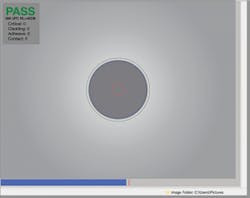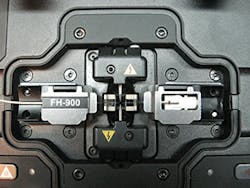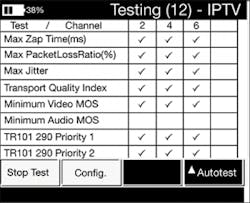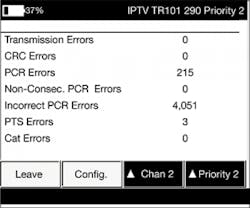Latest from Network Reliability/Testing & Assurance/Cybersecurity/Safety
OTT Needs Testing TLC
Best Practices for IPTV Troubleshooting:
Consumer behavior continues to drive change in how television is delivered. People are moving away from watching TV through cable providers and traditional linear television and moving towards online alternatives like Netflix and Hulu. Even how people consume entertainment is shifting from television sets to smart devices. The shift in consumer behavior forces a paradigm shift to Internet-based delivery methods in Internet Protocol
Television (IPTV) and Over-The-Top (OTT).
OTT streamed content comes over the same open, unmanaged network as email and web browsing. OTT competition significantly increases mature pay-TV markets. ABI Research (www.abiresearch.com) forecasts that live linear OTT video services will grow to approximately seven billion dollars of worldwide revenue by 2021.* Likewise, IPTV uses a private, dedicated network to deliver more consistent service. According to a recent report, IPTV is a far larger segment; the global IPTV market was valued at around USD 34.67 billion in 2015 and is expected to reach USD 93.59 billion in 2021.*
The IPTV market growth is mainly driven by increasing demand of high definition (HD) channels and video on demand. Aiding the growth are government initiatives to increase broadband penetration during the forecast period and the decreasing cost of IPTV services.
Delivering these services comes with many technical challenges such as developing a robust content management system, video transcoding and storage pipelines and application ecosystems, to name a few. To tackle the technical challenges, many operators made significant investments in technology platforms. However, these investments focused on the core and distribution/aggregation segment. While these investments have greatly improved the delivery system, they have failed to solve the physical layer problems that can be served by copper with xDSL, G.fast technology, or FTTx.
Typically, when a customer calls in with a service complaint, the service or application layer is not the issue. In fact, consumers and technicians report that a majority of problems are at the physical layer. We are seeing IPTV providers across the globe modifying their best practices to focus first on the physical layer when it comes to troubleshooting their Last Mile.
Step 1: Start at the customer.
• Isolate offending device(s) furthest downstream
• Then perform diagnostic steps
Step 2: Fix physical layer problems first.
• Physical impairments negatively affect xDSL/PON
• xDSL/PON impairments negatively affect IPTV
Step 3: Use IPTV tests to detect issues in network.
• Continuity errors mask other issues
• PCR jilter can cause packet over/underflow issues
• Isolate utilizing TR101 290 metrics
Cheat Sheets for Super Techs
You can help any technician become a super technician by sharing these simple best practices for different challenges they may face in the field.
Copper Testing Tips
Whether it’s ADSL or even G.fast, a seamless troubleshooting process can catch most issues. We have detailed the ideal testing process here.
Step 1: Detect for any Opens or Cross Battery issues.
Step 2: Detect for any Ring & Tip balance issues with a stress test.
Step 3: Detect for any resistive faults with a leakage test.
Step 4: Detect excessive noise or power influence.
Step 5: Find where the fault is using an RFL or TDS.
Step 6: Look for any attenuation.
Fiber Testing Tips
Fiber optic links that are used for IPTV systems require all connections to be low-loss and low-reflectivity. Surprisingly, fiber that successfully transmits low-bandwidth data signals may not be able to support the high-bandwidths required for IPTV signals.
Step 1: Terminating
Recently we have seen a reversal in recommended termination techniques. There has been a shift away from mechanical connectors because, while there may be installation cost savings, their lifetime ROI is not ideal. Operators and their technicians are finding that fusion splicing provides a low-loss and low-reflectivity connection, and should be used when a connection point is not needed.
Step 2: Cleaning and Inspection
Before any fiber optic connector is mated with another connector, the exposed fiber end needs to be inspected and cleaned. Fiber connectors can be cleaned via a wet/dry method or the dry-cleaning method utilized by the fiber optic cleaning pens. Fiber cleaning pens provide a fast, effective method of cleaning both the connector ferrule and the mating bulkhead.
Most failures in fiber optic networks are a result of the technician employing improper cleaning techniques. Why? Because dirty fiber optic networks will cause reflections. If a fiber link has reflective components, the bit error rates will degrade and the transmitted data will become corrupt. To avoid reflective events, industry best practices such as fusion splicing and using fiber cleaning pens should be employed.
Figure 1. Connector end face passes IEC61300-3-35 testing.
Additionally, technicians should use a video inspection scope that provides a pass/fail certification to the IEC61300-3-35 standard certifying that the connector is clean and free from damage. (See Figure 1.) If a connector is not clean, the debris on the ferrule can cause permanent damage to itself and to any connector it is mated to. This damage along with contamination will cause a high reflectivity event which will degrade IPTV services.
Step 3: Connecting
Splice on connectors provide the flexibility and high performance connectivity specified in Telcordia GR326 standards. In many situations, they outperform mechanical connectors. Additionally, using splice on connectors eliminates the need of a splice tray. (See Figure 2.)
Figure 2. Field fiber being fusion spliced to a Splice on Connector.
Step 4: Qualifying
When the fiber link is installed it must be qualified to prove that it meets design specifications. This can be accomplished by using an Optical Loss Test Set (OLTS). The OLTS can measure the insertion loss and return loss bi-directionally at all service wavelengths with the push of one button. This is much faster, and eliminates the chance for errors when compared to using individual laser sources and optical power meters. The OLTS will not pinpoint the location and magnitude of each individual loss event but rather gives a loss reading for the entire link. The Optical Time Domain Reflectometer (OTDR) is capable of measuring and characterizing each loss event, thus providing critical information needed to pinpoint the location and troubleshoot IPTV failures.
IPTV Specific Testing Practices
Fully testing the physical layer rules out 80% of all issues related to IPTV. Once that is complete, and if the issue persists, then it’s time to focus on the application itself. The most effective way to troubleshoot IPTV focuses on analyzing the 8 metrics shown in Figure 3.
Figure 3. IPTV Metrics
The first 6 metrics are common sense, and are likely part of your current work practices. However, what people tend to forget are the last 2 items on the checklist. These tests provide a health check of the transport stream:
• TR101 290 Priority 1 — used to determine decoding ability and basic monitoring.
• TR101 290 Priority 2 — recommended for continuous or periodic monitoring.
These extra tests are useful from a troubleshooting or even an installation use case. You can see 2 sample metrics from these checkpoints in Figure 4.
Figure 4. TR101 290 Category 1 & 2 Metrics
Proper Testing = QoE
If we examine where communication service providers are investing to improve the end users Quality of Experience (QoE), you see that they have focused squarely in the network rather than The Last Mile.
However, the physical layer is always any application’s Achilles’ heel. If 80% of copper-fed customer service issues come from the physical layer, it stands to reason that a technician needs to spend time troubleshooting this layer before application itself. At the application layer MOS scoring is a great first step in any IPTV testing, and will help provide visibility into the consumers QoE. That said, more attention needs to be paid to the standards-based approach of TR101 290 for a true health check of the system. The good news is that with automation, all these tests from the physical layer to the IPTV layer can be run in a matter of minutes.
Sources:
*IPTV Market for Advertising and Marketing, Media and Entertainment, Gaming, E-Commerce, Healthcare and Medical, Telecommunication & It and Others — Global Industry Perspective, Comprehensive Analysis, and Forecast, 2015-2021. For more information, please visit Research and Markets, and http://www.prnewswire.com/news-releases/iptv-market-for-advertising-and-marketing-media-and-entertainment-gaming-e-commerce-healthcare-and-medical-telecommunication–it-and-others—forecast-2015—2021—research-and-markets-300311962.html.
*Cisco — IPTV and the future of video services. www.cisco.com
Save
Save
Save









